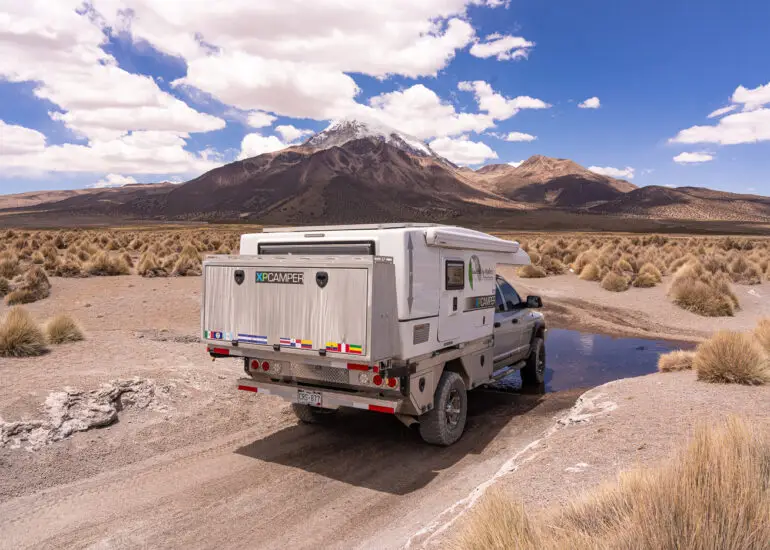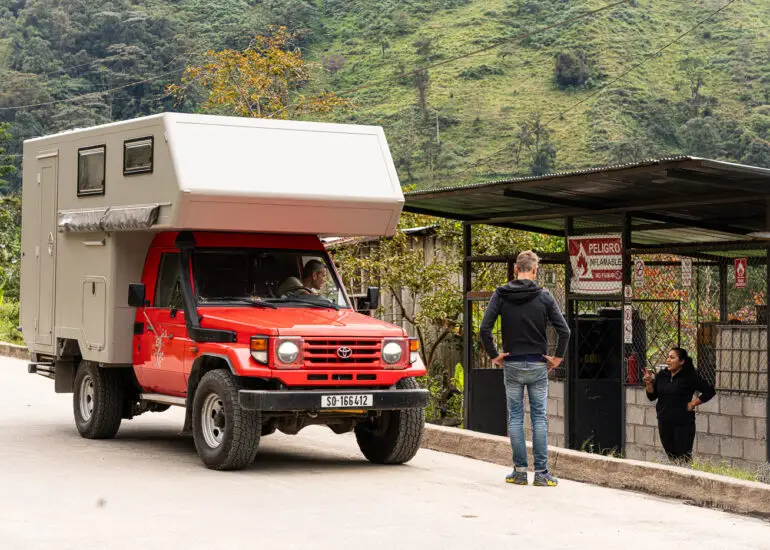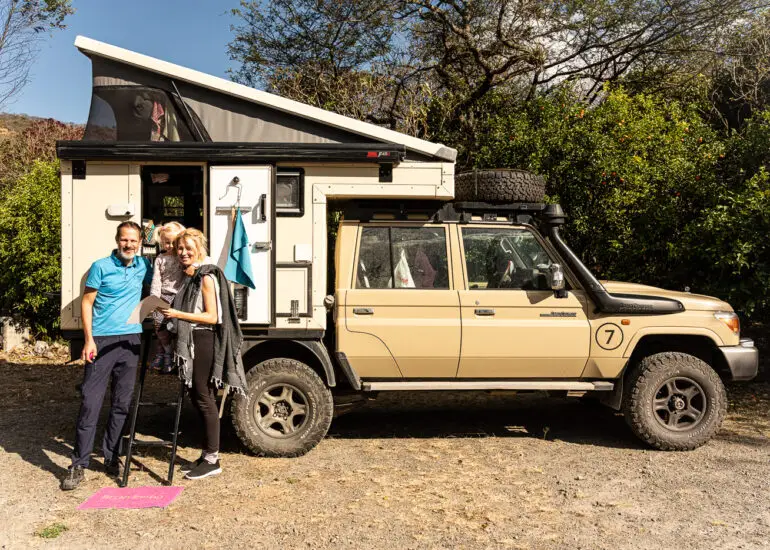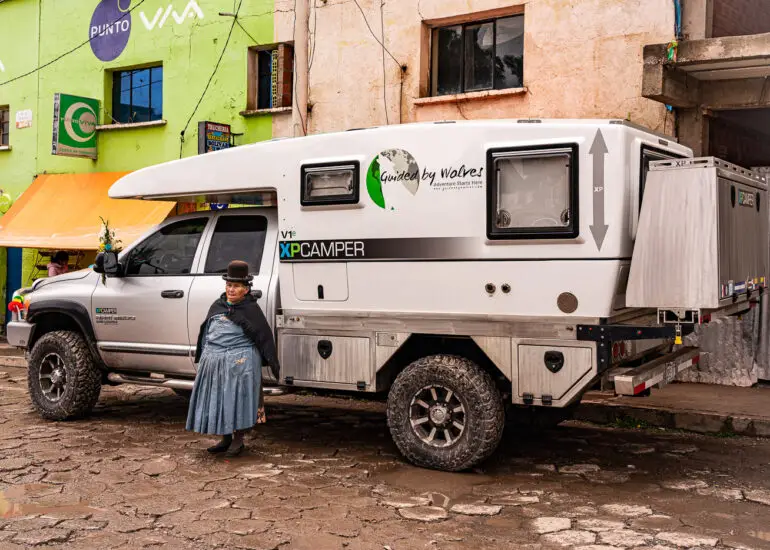Choosing a Vehicle
Choosing a Vehicle
Choosing a vehicle is the most important decision you’ll need to make before embarking on an overland expedition.
The first choice that you will need to make is whether to buy or rent a rig. This decision will depend on the duration and location of your overland expedition. For example, if you are planning a shorter overland expedition to Africa, it probably makes more sense to rent an overland vehicle in Africa than to buy and ship one to Africa, or to buy one in Africa. However, for the purpose of this article, we’ll assume you will be going on a longer overland expedition and buying a vehicle.

Choosing an Overland Expedition Vehicle
Your choice of overland vehicle will depend in large part on:
- How much time you are going to be spending living in vs. living outside of the vehicle.
- How off-road capable you need your vehicle to be.
Let’s evaluate the primary types of overland vehicles based on these two criteria:
SUVs or Pickup Trucks with a Rooftop Tent
A good example of a pickup truck with a rooftop tent is the Toyota Hilux DC 4×4 that Bushlore rents in Africa. Another example is the Expedition Overland Toyota Tacoma which is featured in the Expedition Overland Central and South America videos.
In our opinion, SUVs or pickup trucks with rooftop tents are a great choice for warmer overland expeditions when you are going to be spending a lot of time cooking and hanging out outside of your vehicle. Examples include overland expeditions to Africa or Australia. They are less ideal for colder overland expeditions where you are going to be spending more of your time inside your vehicle, e.g., the altiplano of South America. They are also a good choice if you are going to use one overland expedition vehicle for a variety of different types of overland expeditions. For example, the Bell Family spent years overlanding in their rig all over the world. Another benefit of SUVs or pickup trucks with rooftop tents is that these vehicles are better daily drivers than the other types of overland vehicles described below. So they might be a great choice if you are going to complete overland expeditions here and there, but need a good daily driver when you aren’t exploring the world.
Chassis Mounted Campers
Campers mounted to the chassis of a truck or van are more common in Europe but are less common in the US. An example of a camper mounted to the chassis of a truck is the Earthroamer LTi. And an example of a camper mounted to the chassis of a van is the AEONrv. Interestingly, the Bell Family that I mentioned above converted their Land Rover Defender with a rooftop tent into a chassis mounted truck camper. You can find information on the conversion here. For us, these are perhaps the best overland vehicle for a variety of different types of overland expeditions since they are more comfortable to live, including cook, sleep and work in than other types of overland expedition vehicles since their interiors are larger and warmer. But depending on the chassis they are built on, they can still enable you to get off the beaten path.
Flatbed Pop-Up Truck Campers
Flatbed pop-up truck campers are another great option. These range from reasonably priced pop-up truck campers like the Four Wheel Hawk to much more expensive pop-up truck campers like the Nimbl Evolution. These are also a great choice for different types of overland expeditions, as long as you don’t mind “setting up” and “breaking down” after and before you hit the road (we found that we did mind). If you do buy one of these vehicles, just make sure that the pop-up mechanism is reliable. For example, we owned an XPCamper and had concerns about our ability to repair the electric pop up mechanism if it failed.
Vans
Vans are a great option, especially if you want something that you can use as a daily driver when you aren’t on overland expeditions. Vans, including Ford Transit and Mercedes Sprinters, have gotten very popular in the US. Many overlanders, especially Europeans, complete the Pan-American Highway in vans.
We traveled for a month in a Toyota Hiace on the South Island of New Zealand, and we traveled for several weeks at a time in Ford Transit vans in both Australia, and on the North Island of New Zealand. We plan to travel in a van to finish The Pan-American Highway route by completing the northern part of the Pan-American (Canada, Alaska). We also plan to use a van to explore other parts of the U.S. and more of Mexico.
Slide-In Truck Campers and Expedition Trailers
You’ll notice that we did not cover two types of potential overland expedition vehicles. The first is slide-in truck campers. Although these could theoretically be used for overland expeditions, in our opinion they are just too small for long-term overland expeditions. The second is expedition trailers. These could also be used for overland expeditions, especially in warmer regions like Africa and Australia. However, in our opinion they don’t work well for colder or longer overland expeditions.
Evaluating Different Rigs
Once you have chosen the type of vehicle you want, you’ll need to pick a specific rig. Here are a few criteria which we would recommend using to evaluate different rigs. We have identified each criteria as critical, important or nice to have.
AWD or 4WD (nice to have)
We think that most people overestimate the importance of AWD or 4WD for most overland expeditions. The reality is that your rig is your home, so you are not going to be doing a lot of rock crawling in it. As a result, the reality is that you will probably only need AWD or 4WD to navigate sandy patches of dirt roads. In addition, AWD and 4WD vehicles are more difficult to maintain and repair, especially when you are on the road. Mowgli Adventures has a great article on 2WD vs. AWD or 4WD overland vehicles. However, if you are going to be doing a lot of driving in the sand or snow, an AWD or 4WD vehicle is more important.
Comfortable dinned (criticak if you are buying a live-in rig)
If you are going to live in your rig for extended periods of time, don’t settle for a rig with an uncomfortable dinette. Most overland vehicle manufacturers in Europe understand the importance of this. But for some reason, most overland vehicle manufacturers in the US don’t. For example, we would personally not buy a Winnebago Revel because it doesn’t have a comfortable place to eat and work.
Company with a good reputiona and a proven track record (critical)
After almost losing our entire deposit when XPCamper went out of business, we’ve learned that it’s always better to buy a rig from a company with a good reputation and long track record. This is easier said than done, especially in the US where most overland expedition vehicle companies are smaller companies. If you do purchase an overland expedition vehicle from a smaller company, hire a lawyer to review your purchase contract to ensure that your investment, including your down deposit, is protected. Also, try to avoid purchasing an overland expedition vehicle with proprietary components (like the XPCamper V1e lift mechanism) that would be hard to repair or replace if the company were to go out of business.
A gas powered rig (critical if you are traveling through regions with high sulfur diesel)
If you are going to be traveling through countries with high sulfur diesel buying a gas powered vehicle is essential.
Gear garage (nice to have if you have bikes or lots of gear that you want to keep inside your rig)
Gear garages are common in European motorhomes. They are much less common in the US (the AEONrv and the Winnebago EKKO are the only overland expedition vehicles in the US with gear garages that we are aware of).
Internal heating system (critical in colder climates)
We prefer overland expedition vehicles with an internal heating system, not only to keep the vehicle warm but also to reduce the likelihood that we’ll need to winterize our vehicle in colder climates. Keep in mind that there are big differences between a well designed and poorly designed heating system. Make sure your heating system is easy to access and repair and has a powerful enough blower (and enough vents) to heat the entire vehicle.
Internal shower (critical in colder climates, nice to have in warmer ones)
For us, an internal hot water shower is important for extended trips, despite the fact that we don’t use it that often. In Africa or Australia, an external cold or hot water shower would be fine since it would be more comfortable to take showers outside.
Sufficient clearance, payload and suspension (critical)
Make sure that you know what your vehicle’s payload capacity is and that it can handle the fully loaded weight of your rig. Then, consider adding a lift kit, installing additional leaf springs, installing heavy duty front coil springs and/or replacing your tires and wheels to make your vehicle a bit more capable on rougher dirt roads. Keep in mind that installing high end suspension components isn’t a core competency of most overland vehicle manufacturers so consider hiring a specialist to upgrade your suspension.
Well designed electrical system (critical)
In our opinion, this is perhaps the most important criteria for an overland expedition vehicle. And it’s amazing how many overland expedition vehicle manufacturers get this wrong. Frederick Cook has done a great job of providing an overview of what a well designed electrical system looks like in his article Watts Up?
Our Overlanding Resources
Here are some of our favorite related overlanding resources. Please send us additional ideas!
Blogs and websites
- Mowgli Adventures (Angela and Graham’s website) is a great source of information on overland cooking, RV conversions, van life and van life. They have also written two great books on overland vehicle electrical systems.
- Tucks Truck (The Tucks’ website) includes a bunch of great trip reports and is a great source of information on planning overland expeditions, including insurance and shipping.
Comments are closed.






